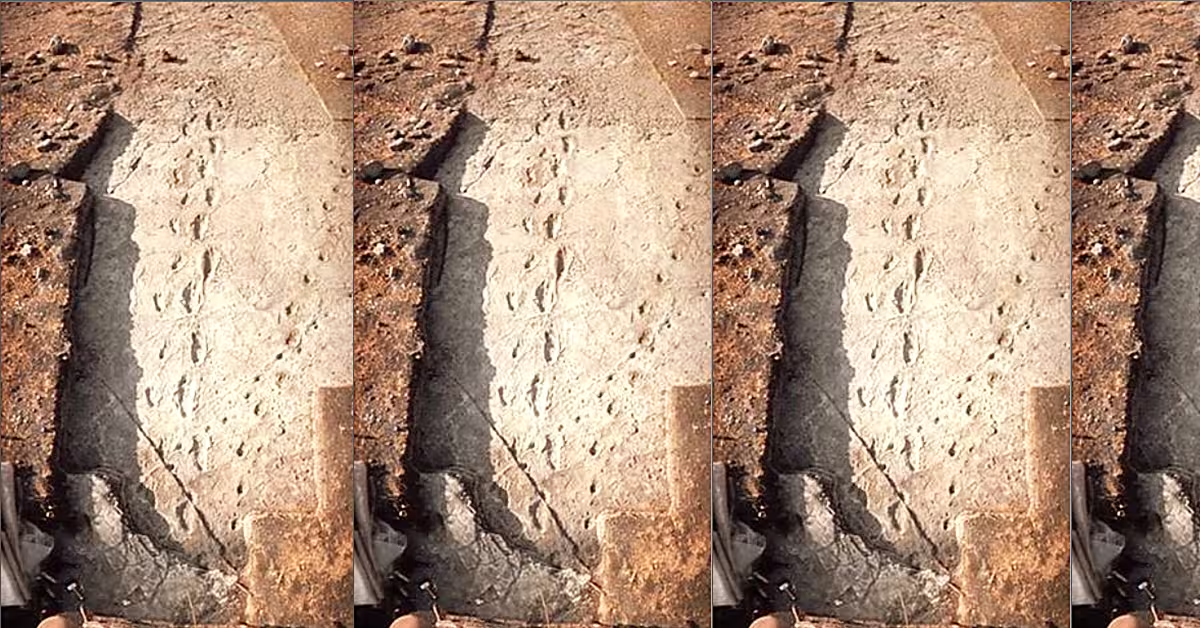Last updated on May 7th, 2025 at 04:39 pm
Footprints in the Ashes of Time is a captivating story of Mary Leakey’s discovery of 3.6M-year-old hominid footprints, reshaping human evolution.
Background of Footprints in the Ashes of Time
Footprints in the Ashes of Time by Mary D. Leakey is more than just a chronicle of paleoanthropological discovery—it is a personal and scientific narrative etched into the very bedrock of human origins. Published after decades of groundbreaking fieldwork, Footprints in the Ashes encapsulates Leakey’s meticulous research at the famed Laetoli site in Tanzania, where she unearthed one of the most iconic and poignant pieces of early human evidence: the fossilized footprints of a hominin species preserved in volcanic ash.
These “footprints in the ashes” were discovered in 1978, dating back roughly 3.6 million years and attributed to Australopithecus afarensis, the same species as the famous “Lucy” skeleton. Preserved by a volcanic eruption and later solidified by time, these footprints provided the first conclusive evidence that early human ancestors walked upright long before they developed larger brains or complex tools. Mary Leakey’s account in Footprints in the Ashes combines scientific rigor with a deep reverence for the silent testimony of these ancient beings who unknowingly etched their journey into the earth’s memory.
By contextualizing the discovery within broader human evolution, Footprints in the Ashes also sheds light on Leakey’s role as a pioneering woman in science—an often-overlooked dimension of this profound work. With elegant prose and empirical authority, the book transports readers not only into the terrain of ancient footprints, but into the intellectual terrain of discovery itself.
Footprints in the Ashes of Time
The discovery indicated that hominids walked erect much earlier than was previously thought, prompting the scientific community to revise assumptions about human evolution. Read more about Mary Leakey on the Smithsonian National Museum of Natural History website.
It happened some 3,600,000 years ago, at the onset of a rainy season. The East African landscape stretched then, much as it does now, in a series of savannas punctuated by wind-sculptured acacia trees. To the east the volcano now called Sadiman heaved restlessly, spewing ash over the flat expanse known as Laetoli. Learn about the Laetoli footprints on the UNESCO World Heritage Centre website.
The creatures that inhabited the region, and they were plentiful, showed no panic. They continued to drift on their random errands. Several times Sadiman blanketed the plain with a thin layer of ash.
Tentative showers, precursors of the heavy seasonal rains, moistened the ash. Each layer hardened, preserving in remarkable detail the footprints left by the ancient fauna. The Laetolil Beds, as geologists designate the oldest deposits at Laetoli, captured a frozen moment of time from the remote past—a pageant unique in prehistory. (Explore the geology of the Laetolil Beds at Berkeley’s Museum of Paleontology).
Our serious survey of the beds, which lie in northern Tanzania 30 miles by road south of Olduvai Gorge, began in 1975 and gained intensity last summer after the discovery of some startling footprints. This article must stand as a preliminary report; further findings will almost certainly modify early interpretations.
Still, what we have discovered to date at Laetoli will cause yet another upheaval in the study of human origins. For in the gray, petrified ash of the beds—among the spoor of the extinct predecessors of today’s elephants, hyenas, hares—we have found hominid footprints that are remarkably similar to those of modern man. Prints that, in my opinion, could only have been left by an ancestor of man. Prints that were laid down an incredible 3,600,000 years ago!
Read a summary of Mary Leakey’s findings on the Laetoli footprints by the Natural History Museum, UK.
My late husband, Dr. Louis S. B. Leakey, and I had first explored the Laetolil Beds in 1935. In that year we were searching for fossils in Olduvai Gorge when Masai tribesmen told us of the rich remains at Laetoli, which in their language refers to the red lily that grows there in profusion. When heavy rains ended the Olduvai excavation season, we made the difficult, two-day journey south.
We did find fossils, but they were much more fragmented than those of Olduvai. At that time, accurate dating was impossible. So we left the site. A German expedition combed the beds in 1938-39, and we ourselves returned twice with indifferent results. But I could not help feeling that, somehow, the mystique of Laetoli had eluded us.
Then, in 1974, two things occurred. I was drawn back once more to these ancient volcanic deposits, and one of my African associates, Mwongela Mwoka, found a hominid tooth. Analysis of the lava that overlies the beds assigned the tooth an age of at least 2,400,000 years. Since this is older than anything at Olduvai, I decided to concentrate my efforts at Laetoli. In 1975, with National Geographic Society support and the cooperation of the Tanzanian Government and its director of antiquities, A. A. Mturi, I mounted an intensive campaign.
For almost two field seasons we diligently collected hominid and other fossils. Then, as is so often the case in pivotal discoveries, luck intervened. One evening Dr. Andrew Hill of the National Museums of Kenya and several colleagues were larking about on the beds, pelting each other with dry elephant dung. As Andrew ducked low to avoid one such missile, he noticed a series of punctures in the volcanic tuff. When close examination indicated that they were animal footprints, we commenced to study them in earnest.
In 1976 Peter Jones, my assistant and a specialist in stone tools, and my youngest son, Philip, noticed what they believed to be a trail of hominid footprints. After considerable analysis I agreed and announced the discovery the following year. Of the five prints, three were obscured by overlying sediment that was impossible to remove. The two clear examples, broad and rather curiously shaped, offered few clues to the primate that had trudged across the plain so long ago.
Nonetheless, the implications of this finding were enormous. Dr. Garniss Curtis of the University of California at Berkeley undertook to date the footprint strata. These deposits possess relatively large crystals of biotite, or black mica. Biotite from ash overlying the prints, when subjected to potassium-argon testing, showed an age of about 3.6 million years; that from below tested at about 3.8 million years. The footprints had been preserved sometime within this span. Dr. Richard L. Hay, also of Berkeley, showed that the ash forming the layers fell within a month’s time.
The hominid footprints attested, in my considered opinion, to the existence of a direct ancestor of man half a million years before the earliest previous evidence—fossils unearthed by Dr. Donald C. Johanson and his party in the Afar triangle of Ethiopia beginning in 1973.
Faced with this, we largely abandoned our hunt for fossils and focused our three-month campaign of 1978 on the footprints—plotting and photographing them, making plaster and latex casts, and even removing certain specimens.
Meanwhile, Dr. Paul Abell Lovejoy of Kent State University in Ohio studied a knee joint from Ethiopia—the bottom of the femur and the top of the tibia—and concluded that the Afar hominid had walked upright, with a free, bipedal gait.
Our footprints confirm this. Furthermore, Dr. Louise Robbins of the University of North Carolina, Greensboro, an anthropologist who specializes in the analysis of footprints, visited Laetoli and concluded: “The movement pattern of the individual is a bipedal walking gait, actually a stride—and quite long relative to the creature’s small size. Weight-bearing pressure patterns in the prints resemble human ones … “
I can only assume that the prints were left by the hominids whose fossils we also found in the beds. In addition to part of a child’s skeleton, we uncovered adult remains—two lower jaws, a section of upper jaw, and a number of teeth.
Where can we place the Laetoli hominids and their Afar cousins in the incomplete mosaic of the rise of man? This question, quite honestly, is a subject of some contention among paleontologists. One school, including Dr. Johanson, classifies them as Australopithecines.
But the two forms of Australopithecus, gracile and robust, represent, in my opinion, evolutionary dead ends. These man apes flourished for their season, and perished—unsuccessful twigs on the branch that produced mankind. Of course, the Laetoli hominid resembles the gracile Australopithecus, but I believe that, so far back in time, all the hominids shared certain characteristics. However, the simple evidence of the footprints, so very much like our own, indicates to me that the Laetoli hominid stands in the direct line of man’s ancestry.
We have encountered one anomaly. Despite three years of painstaking investigation by Peter Jones, no stone tools have been found in the Laetolil Beds. With their hands free, one would have expected this species to have developed tools or weapons of some kind. But, except for the ejecta of erupting volcanoes, we haven’t found a single stone introduced into the beds. So we can only conclude, at least for the moment, that the hominids we discovered had not yet attained the toolmaking stage.
While the hominid prints rank as the most exciting of our discoveries at Laetoli, there is also a petrified record of Pliocene animal life. Oddly—or perhaps not so oddly, given the geologic continuity of East Africa—we find the same type of wildlife in roughly the same proportions as exist today.
Before the first fall of ash, the prehistoric plain of Laetoli apparently possessed a normal array of vegetation. Beneath the bottom layer we find fossilized twigs, small branches, and grass. Thereafter, with the terrain buried in barren gray dust, animals continued to drift across in their habitual patterns. Why did they do so, with so little sustenance present? With the data available at this point, we just cannot explain it.
But the footprints are visible in their plenitude. Countless hares have pocked the ash with their distinctive hopping pattern. Baboon prints lie in profusion; all we have found possess a narrow heel similar to those of smaller present-day females. Baboons, incidentally, still arrogantly patrol the beds. Deinotherium, a prehistoric relative of today’s elephant, lumbered through, its huge footprints obliterating the strata beneath.
We encountered a variety of antelope prints, large and small. In studying these, we enlisted the aid of two African trackers, members of the Hadza and Wasukuma tribes. Because the extinct species possess hooves of roughly the same shape as their living relatives, the trackers provided valuable identifications.
In addition to footprints we also have found skeletal traces of both white and black rhinos, two types of giraffe—one as tall as today’s species, the other a pygmy—and two genera of pigs. Various carnivores prowled across the ash, including one very large saber-toothed cat; hyenas were numerous.
A unique discovery, though, is a pair of prints left by a chalicothere. This strange creature had claws on its feet; yet it was an ungulate rather than a carnivore and ate only vegetation. To my knowledge, our prints are the only ones ever discovered.
But in the end one cannot escape the supreme importance of the presence of hominids at Laetoli. Sometimes, during the excavating season, I go out and watch the dusk settle over the gray tuff with its eerie record of time long past. The slanting light of evening throws the hominid prints into sharp relief, so sharp that they could have been left this morning.
I cannot help but think about the distant creatures who made them. Where did they come from? Where were they going? We simply do not know. It has been suggested that they were merely crossing this scorched plain toward the greener ridges to the north. Perhaps so.
In any case, those footprints out of the deep past, left by the oldest known hominids, haunt the imagination. Across the gulf of time I can only wish them well on that prehistoric trek. It was, I believe, part of a greater and more perilous journey, one that—through millions of years of evolutionary trial and error, fortune and misfortune—culminated in the emergence of modern man.
Significance of Footprints in the Ashes of Time
The significance of Footprints in the Ashes extends well beyond the realm of anthropology; it marks a turning point in our understanding of what it means to be human. These ancient steps—immortalized in volcanic ash—speak across millennia, revealing that the human story did not begin with empires or writing, but with bare feet pressed into soft earth.
Footprints in the Ashes changed the academic conversation by offering the earliest concrete proof of bipedalism, the evolutionary trait that set humans apart from other primates. This discovery not only filled a crucial gap in the fossil record but also affirmed Darwinian theory in tangible, indisputable terms. It repositioned Africa as the cradle of humanity and made Laetoli as culturally significant as the pyramids or Stonehenge—an archaeological Rosetta Stone for evolutionary biology.
Moreover, Footprints in the Ashes serves as a testament to the power of perseverance in scientific inquiry. Leakey’s fieldwork spanned harsh conditions, scientific skepticism, and gendered barriers. Yet she persisted, documenting the site with painstaking detail and offering interpretations that continue to influence the field today. The book emphasizes that the discovery of the Laetoli footprints was not an isolated event, but the result of cumulative, patient scholarship. Thus, Footprints in the Ashes stands as a landmark not just of paleoanthropology, but of the human intellectual spirit.
For students, educators, and researchers alike, Footprints in the Ashes offers a rare synthesis of empirical evidence and philosophical reflection. The imagery of ancient humans leaving marks in volcanic ash becomes a metaphor—one that frames our own time-bound existence against the vastness of geological and evolutionary history.
Conclusion
In conclusion, Footprints in the Ashes of Time by Mary D. Leakey is far more than a fossil record—it is a monument in print, a narrative that humanizes science and immortalizes a moment when early hominins unknowingly walked into eternity. The power of Footprints in the Ashes lies in its ability to make ancient history immediate and personal. Through Leakey’s eyes, we do not merely observe the past; we feel it beneath our feet.
These footprints in the ashes connect us to an ancestor not through myths or stories, but through evidence—silent, stoic, and stamped in stone. In a world obsessed with speed and noise, Footprints in the Ashes offers the quiet majesty of discovery, of waiting patiently for the earth to speak.
Ultimately, Footprints in the Ashes is a reminder that our origins are both humble and extraordinary. And just as those early beings left their mark, so too has Mary Leakey—through this enduring and monumental work. For anyone curious about the human journey, Footprints in the Ashes is not just worth reading—it is indispensable.
FAQ
✅ 1: What is Footprints in the Ashes of Time by Mary D. Leakey?
Answer:
Footprints in the Ashes of Time is Mary D. Leakey’s groundbreaking account of the 3.6-million-year-old fossilized hominin footprints discovered at Laetoli, Tanzania. Preserved in volcanic ash, these footprints provide the earliest conclusive evidence of bipedalism in human ancestors. The book combines scientific discovery with personal insight, illustrating Leakey’s pivotal role in shaping modern paleoanthropology.
✅ 2: Why is Footprints in the Ashes significant in anthropology?
Answer:
Footprints in the Ashes is significant because it documents the earliest known proof of upright walking in human evolution. Mary D. Leakey’s discovery at Laetoli confirmed key aspects of Darwinian theory, cemented Africa’s role as the cradle of humanity, and shifted the global understanding of early hominins. The book remains essential in anthropology, evolution, and scientific history.
✅ 3: What do the Laetoli footprints in Footprints in the Ashes reveal?
Answer:
The Laetoli footprints, featured in Footprints in the Ashes, reveal that early hominins walked upright nearly 4 million years ago. Preserved in volcanic ash, the prints offer rare, direct evidence of bipedalism long before the advent of tools or large brains, reshaping the narrative of human evolution.
✅ 4: What is the main message of Footprints in the Ashes of Time?
Answer:
The main message of Footprints in the Ashes of Time is that our ancient ancestors left behind more than fossils—they left evidence of behavior, movement, and early humanity. Mary Leakey’s work reminds us that the search for human origins is grounded in patience, perseverance, and the silent testimony of the earth.
✅ 5: Who should read Footprints in the Ashes and why?
Answer:
Students, scientists, and curious readers should read Footprints in the Ashes for its unparalleled insight into early human evolution. Combining compelling storytelling with scientific detail, Mary Leakey’s book is both an intellectual journey and a tribute to discovery itself.
Would you like these converted into structured FAQ schema (JSON-LD) for embedding in a WordPress post to enhance your SEO and visibility in search results?






